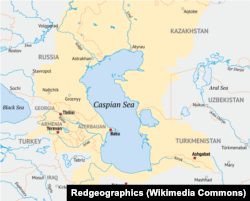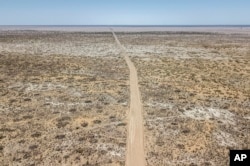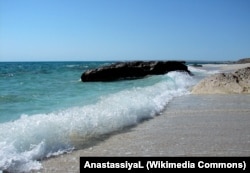Residents of Aqtau, a Kazakhstani port city located on the northeastern shore of the Caspian Sea, are on edge these days. For more than two decades, they have watched the Caspian Sea shrink and the local economy wither.
As the sea receded, the city's population, estimated at 250,000, saw disruptions in trade and experienced difficulties with the supply of drinking water. Aqtau city officials declared a state of emergency over declining water levels in June 2023. The Kazakh Ministry of Environment said the situation was "critical."
With its coastline stretching 6,819 kilometers (4,237 miles), the Caspian Sea is the world's largest inland body of water and is shared by Azerbaijan, Kazakhstan, Iran, Russia and Turkmenistan. The sea plays a key role in the economies of these countries, supporting such industries as fishing, agriculture and tourism.
Azamat Sarsenbayev, a documentary maker and environmental activist who grew up in Aqtau, said the drop in sea level has been most noticeable on the Kazakhstani segment of the coast, which is the shallowest.
"I remember as a kid, I and my friends would be afraid to swim 10 meters from the shore. These days, the sea has become so shallow that we can walk for 200 meters on the rocks, which once used to be deep under water," he said in an interview with VOA.
Severe drop in level
Kazakhstan's Institute of Hydrobiology and Ecology estimates that the Caspian Sea has reached the level of 29 meters (95 feet) below the level of the oceans and open seas. (Scientists use the Baltic Sea as a reference point to measure fluctuations in the Caspian Sea level.) By comparison, in 1995, the sea level was 26 meters (85 feet) below the Baltic Sea level.
Early signs of the Caspian Sea’s shrinkage appeared in the mid-2000s, but in the past years, the rate at which the level is dropping has accelerated, according to this institute, which estimates the loss rate at 23 centimeters (9 inches) per year.
Scientists are still debating the causes for the declining water levels in the Caspian. Some Kazakhstani environmental experts say that changes in climate and intensive human use of the Volga and the Ural, two main rivers that originate in Russia and flow into the sea, are affecting the Caspian.
Kirill Osin, director of a Kazakh environmental nonprofit organization Eco Mangystau, told VOA, "The first factor is global climate change is at work.
“The days are becoming hotter, and the volume of precipitation is going down,” Osin said. “Accordingly, the level of water evaporation is not compensated by precipitation. The second factor has to do with what is happening with the [tributary] rivers. More than 140 rivers flow into the Caspian Sea, but the two rivers — the Volga and the Ural — are the two main arteries, and they are degrading like never before. Look at the condition of the Ural River. The river has practically dried up. The level of the Volga is also declining."
Osin added, "Russia is building its own water reservoirs, taking up a significant amount of water for agricultural and industrial needs. Against the backdrop of changing climate and decrease in precipitations, the rivers are not able to replenish the volume of water."
In an analysis paper published in October 2023, Vali Kaleji, an Iranian researcher, wrote: "In recent years, Russia has built 40 dams on the Volga River and 18 more dams are under study and construction. This has reduced the flow of water entering the Caspian Sea.”
A cyclical problem?
Some scientists dispute the claim that the reduced flow of water is at play behind the shrinking of the Caspian Sea.
In a 2022 interview with Azerji journalists, Telman Zeinalov, director of the Azerbaijani Center for Ecological Forecasting, said that changes with the Caspian Sea volume were cyclical in nature.
“It is proven that the rise or decline of the Caspian has exclusively cyclical nature,” he said. “The rise in the temperature definitely affects the level of the Caspian, but it is not a sufficient cause for the shrinking of the sea."
Pyotr Bukharitsyn, a Russian oceanologist working for the Institute of Oceanology of the Russian Academy of Sciences, also posits that the Caspian Sea's fluctuations are natural and cyclical.
Data from Kazakhstan's Institute of Hydrobiology and Ecology provides evidence that the level of water in the Caspian Sea has been fluctuating over time. In the mid-1970s, the water level decreased to 29 meters (95 feet) and then rose to 26 meters (85 feet) in the 1990s, the institute documented.
The causes are not the only thing in dispute. Environmental activists and scientists hold differing views on the potential repercussions from the shrinking sea, too.
A 2020 study projected that if the trend continues, by 2100, the sea level would decline by 18 meters (59 feet), losing approximately a quarter of its current size, a scenario that would have devastating impacts for humans and the environment alike.
Just like the Aral Sea?
For environmental activists such as Sarsenbayev, such scenarios evoke strong memories of the Aral Sea tragedy.
"The Caspian Sea can repeat the fate of the Aral Sea," Sarsenbayev said.
Soviet agricultural policies that diverted the Aral Sea's tributary rivers (the Amu Darya and the Syr Darya) to feed cotton fields in Uzbekistan resulted in a mostly dried-up lake, which is now split into Kazakh and Uzbek sections.
As the Aral Sea shrank to one-tenth of its original volume, thousands of residents lost jobs associated with the fishing industry. Many more departed from the region to avoid chronic diseases caused by desertification of the region and frequent sandstorms carrying pesticides and harmful chemicals.
Eco Mangystau’s Osin disagrees with this gloomy scenario.
"I would not give such pessimistic forecasts as I believe that water levels will rise with time. Testimonies from local fishermen who experienced numerous fluctuations in the level of the Caspian in their lifetime attest to this," he said.
"The situation has not reached a critical point. At the same time, we should not ignore the problem. We need to closely monitor the situation," he said.
Residents already feel impact
The causes and long-term impacts might not be clear, but in some settlements and towns along the Caspian shore, people are already feeling the immediate impact from the receding waters.
In Turkmenistan, for example, ferries that carried residents and tourists have reportedly stopped operating between some towns because the sea level has dropped.
According to Sarsenbayev, the receding of the sea has made it difficult for vessels entering Aqtau, Kazakhstan's only port, to operate with full loads of cargo. Declining water levels have also reportedly disrupted the work of the Aqtau water desalination plant, the only facility supplying drinking water to the city's population.
It is not just Kazakh and Turkmens who are paying the price. Russian cities and settlements along the Volga and the Ural are struggling, too.
A former Kyrgyzstani journalist who covered environmental issues told VOA that "Russian cities located on the Volga have been grappling with decrease in the volume of the river for the past five years. As the river is drying up, this affected river navigation and trade."
The receding sea level has also affected the natural habitat for seals, crustaceans and sturgeons. The population of Caspian seals has reportedly shrunk from 1 million at the start of the 20th century to 110,000 by 2024.
What’s being done
Regional governments are paying some attention to the Caspian Sea problem. In late June 2022, the shrinking of the sea was discussed during the Summit of the Caspian Littoral States held in Ashgabat, Turkmenistan.
In his September 2023 address before the U.N. General Assembly, Kazakh President Kasymzhomart Tokayev said, "The saving of the Caspian Sea must become a top priority issue, which requires long-term international collaboration."
The subject of preserving the sea was also discussed during Tokayev's visit to Russia in November 2023. Following the meeting, Putin said, "Russia and Kazakhstan are paying significant attention to saving the ecosystem of the Caspian Sea."
In January 2024, the Kazakh government created the Caspian Sea Research Institute, a government-funded group to study the problems of the Caspian Sea.
For environmental activists, such responses by the regional governments are not enough.
Osin said, "As of now, I haven't seen that any significant measures were taken [by the government]. At the level of the president and the government, there are some words and declarations, but no concrete decisions are adopted. The water diplomacy with the Russian side on the River Volga should have started yesterday."
The Kazakh government has refuted claims that the government is not doing enough.
In a June 2023 interview with Kazakh journalists, Zulfiya Suleimenova, the minister of ecology and natural resources of Kazakhstan, said, "Without solving these issues, without effective measures of all the Caspian states, it would be hard to talk about the saving [of the sea]. The real issue is not about shouting [about the problem], it is about solving the problem effectively.”














